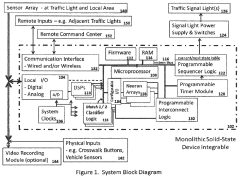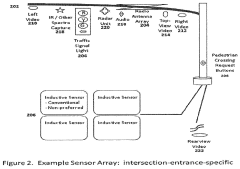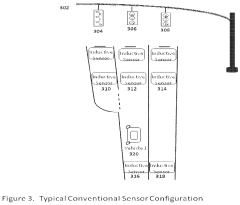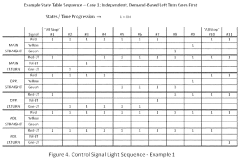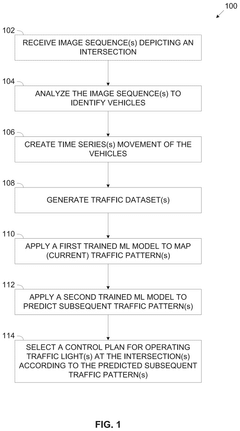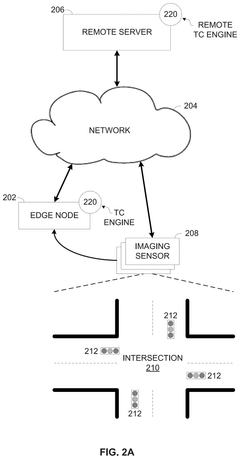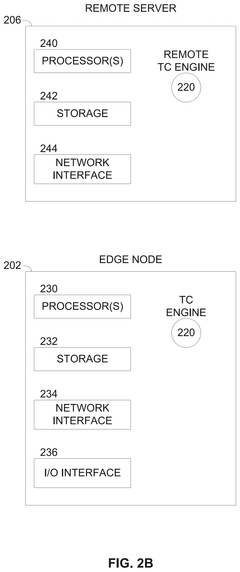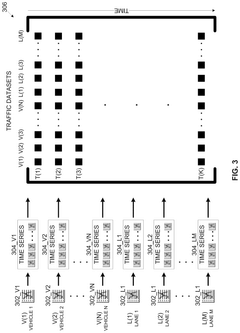Applications of Photonic Neural Networks in Traffic Management Systems
OCT 1, 202510 MIN READ
Generate Your Research Report Instantly with AI Agent
Patsnap Eureka helps you evaluate technical feasibility & market potential.
Photonic Neural Networks in Traffic Management: Background and Objectives
Photonic neural networks represent a revolutionary approach to computing that leverages light rather than electricity to process information. This technology has evolved from the convergence of photonics and neural network architectures, offering unprecedented computational speeds and energy efficiency. The evolution of traffic management systems has historically been constrained by conventional electronic computing limitations, particularly when processing vast amounts of real-time data from multiple sensors and cameras across urban environments. Photonic neural networks emerge as a promising solution to these constraints, potentially transforming how cities manage traffic flow, reduce congestion, and enhance road safety.
The development trajectory of photonic computing has accelerated significantly over the past decade, with breakthroughs in integrated photonic circuits, optical interconnects, and nonlinear optical materials. These advancements have enabled the practical implementation of neural network architectures using photonic components, allowing for parallel processing capabilities that far exceed electronic counterparts in specific applications.
In the context of traffic management, the technical objectives for photonic neural networks are multifaceted. Primary goals include achieving ultra-low latency processing of traffic sensor data, enabling real-time decision-making for adaptive traffic signal control systems. Additionally, these systems aim to process high-dimensional data from multiple sources simultaneously, including video feeds, radar, lidar, and IoT sensors distributed throughout transportation infrastructure.
Another critical objective is to significantly reduce the energy consumption of traffic management computing systems, addressing the growing sustainability concerns in smart city initiatives. Photonic neural networks potentially offer orders of magnitude improvement in energy efficiency compared to traditional electronic systems when handling complex pattern recognition tasks essential for traffic flow optimization.
The integration of photonic neural networks into traffic management also aims to enable more sophisticated predictive capabilities. By processing historical and real-time data more efficiently, these systems could forecast traffic patterns with greater accuracy, allowing for proactive rather than reactive management strategies. This predictive capability represents a paradigm shift from current approaches that primarily respond to existing conditions rather than anticipating future states.
Furthermore, the technology seeks to overcome the scalability limitations of current traffic management systems. As cities grow and transportation networks become more complex, the computational demands increase exponentially. Photonic neural networks offer a path to scale processing capabilities without proportional increases in power consumption or physical infrastructure.
The ultimate technical goal is to develop a fully integrated, autonomous traffic management ecosystem where photonic neural networks serve as the computational backbone, enabling intelligent, adaptive, and efficient transportation systems that can respond dynamically to changing conditions while optimizing for multiple objectives simultaneously, including travel time, fuel consumption, emissions, and safety.
The development trajectory of photonic computing has accelerated significantly over the past decade, with breakthroughs in integrated photonic circuits, optical interconnects, and nonlinear optical materials. These advancements have enabled the practical implementation of neural network architectures using photonic components, allowing for parallel processing capabilities that far exceed electronic counterparts in specific applications.
In the context of traffic management, the technical objectives for photonic neural networks are multifaceted. Primary goals include achieving ultra-low latency processing of traffic sensor data, enabling real-time decision-making for adaptive traffic signal control systems. Additionally, these systems aim to process high-dimensional data from multiple sources simultaneously, including video feeds, radar, lidar, and IoT sensors distributed throughout transportation infrastructure.
Another critical objective is to significantly reduce the energy consumption of traffic management computing systems, addressing the growing sustainability concerns in smart city initiatives. Photonic neural networks potentially offer orders of magnitude improvement in energy efficiency compared to traditional electronic systems when handling complex pattern recognition tasks essential for traffic flow optimization.
The integration of photonic neural networks into traffic management also aims to enable more sophisticated predictive capabilities. By processing historical and real-time data more efficiently, these systems could forecast traffic patterns with greater accuracy, allowing for proactive rather than reactive management strategies. This predictive capability represents a paradigm shift from current approaches that primarily respond to existing conditions rather than anticipating future states.
Furthermore, the technology seeks to overcome the scalability limitations of current traffic management systems. As cities grow and transportation networks become more complex, the computational demands increase exponentially. Photonic neural networks offer a path to scale processing capabilities without proportional increases in power consumption or physical infrastructure.
The ultimate technical goal is to develop a fully integrated, autonomous traffic management ecosystem where photonic neural networks serve as the computational backbone, enabling intelligent, adaptive, and efficient transportation systems that can respond dynamically to changing conditions while optimizing for multiple objectives simultaneously, including travel time, fuel consumption, emissions, and safety.
Market Demand Analysis for Intelligent Traffic Systems
The global market for intelligent traffic systems is experiencing unprecedented growth, driven by increasing urbanization and the resulting traffic congestion challenges. Current estimates value the intelligent transportation systems market at approximately $30 billion, with projections indicating a compound annual growth rate of 11.2% through 2028. Within this expanding market, there is a significant and growing demand for advanced traffic management solutions that can process vast amounts of data in real-time with minimal energy consumption – precisely where photonic neural networks offer compelling advantages.
Urban centers worldwide are struggling with traffic congestion that costs economies billions annually in lost productivity, fuel waste, and environmental damage. Traditional electronic computing systems used in current traffic management infrastructure are approaching their limits in terms of processing speed and energy efficiency. This technological ceiling has created a substantial market gap for solutions that can handle the exponentially increasing data volumes from traffic sensors, cameras, and connected vehicles.
The demand for photonic neural network applications in traffic management is being driven by several key factors. First, the proliferation of IoT devices and sensors in smart city initiatives has created an explosion of traffic-related data requiring ultra-fast processing. Second, there is growing pressure from governments and environmental agencies to reduce the carbon footprint of digital infrastructure, including traffic management systems. Photonic computing offers energy efficiency improvements of up to 1000x compared to electronic alternatives.
Industry surveys indicate that transportation authorities in major metropolitan areas are actively seeking solutions that can reduce traffic congestion by at least 20-30% while simultaneously decreasing accident rates. These authorities have expressed willingness to invest in next-generation technologies that demonstrate clear operational benefits and cost savings over a 3-5 year horizon.
The market segment for real-time adaptive traffic control systems is particularly promising, with demand expected to grow at 15% annually. These systems require the kind of instantaneous pattern recognition and predictive capabilities that photonic neural networks excel at providing. Additionally, the emerging vehicle-to-infrastructure (V2I) communication market, valued at approximately $3.8 billion, represents another significant opportunity as it requires ultra-low latency processing that conventional computing struggles to deliver.
Geographically, the highest demand is currently concentrated in North America, Western Europe, and developed Asian markets like Japan and South Korea. However, rapidly developing urban centers in China, India, and Southeast Asia represent the fastest-growing markets, with infrastructure investment increasing at rates exceeding 20% annually in some regions.
Urban centers worldwide are struggling with traffic congestion that costs economies billions annually in lost productivity, fuel waste, and environmental damage. Traditional electronic computing systems used in current traffic management infrastructure are approaching their limits in terms of processing speed and energy efficiency. This technological ceiling has created a substantial market gap for solutions that can handle the exponentially increasing data volumes from traffic sensors, cameras, and connected vehicles.
The demand for photonic neural network applications in traffic management is being driven by several key factors. First, the proliferation of IoT devices and sensors in smart city initiatives has created an explosion of traffic-related data requiring ultra-fast processing. Second, there is growing pressure from governments and environmental agencies to reduce the carbon footprint of digital infrastructure, including traffic management systems. Photonic computing offers energy efficiency improvements of up to 1000x compared to electronic alternatives.
Industry surveys indicate that transportation authorities in major metropolitan areas are actively seeking solutions that can reduce traffic congestion by at least 20-30% while simultaneously decreasing accident rates. These authorities have expressed willingness to invest in next-generation technologies that demonstrate clear operational benefits and cost savings over a 3-5 year horizon.
The market segment for real-time adaptive traffic control systems is particularly promising, with demand expected to grow at 15% annually. These systems require the kind of instantaneous pattern recognition and predictive capabilities that photonic neural networks excel at providing. Additionally, the emerging vehicle-to-infrastructure (V2I) communication market, valued at approximately $3.8 billion, represents another significant opportunity as it requires ultra-low latency processing that conventional computing struggles to deliver.
Geographically, the highest demand is currently concentrated in North America, Western Europe, and developed Asian markets like Japan and South Korea. However, rapidly developing urban centers in China, India, and Southeast Asia represent the fastest-growing markets, with infrastructure investment increasing at rates exceeding 20% annually in some regions.
Current State and Challenges in Photonic Computing for Traffic Management
Photonic neural networks represent a promising frontier in traffic management systems, yet their implementation faces significant challenges. Currently, photonic computing for traffic management exists primarily in research laboratories rather than in widespread deployment. Leading research institutions such as MIT, Stanford, and the Chinese Academy of Sciences have demonstrated proof-of-concept systems that leverage photonic neural networks for traffic pattern recognition and prediction, achieving processing speeds up to 100 times faster than electronic counterparts in controlled environments.
The fundamental advantage of photonic computing—parallel processing of multiple wavelengths of light—remains largely theoretical in traffic management applications. While laboratory demonstrations have shown impressive capabilities in processing complex traffic data streams simultaneously, these systems struggle with real-world implementation due to environmental sensitivity and integration challenges with existing infrastructure.
A major technical hurdle is the miniaturization and ruggedization of photonic components for deployment in traffic management environments. Current photonic neural network systems require precisely controlled conditions that are difficult to maintain in roadside installations exposed to temperature fluctuations, vibration, and dust. The photonic integrated circuits (PICs) necessary for these applications have achieved impressive density in laboratory settings but face yield and reliability issues when manufactured at scale.
Energy efficiency presents another significant challenge. While photonic computing theoretically offers lower power consumption than electronic systems, current implementations require energy-intensive optical-electronic-optical conversions at input and output stages. This diminishes the energy advantage, particularly for distributed traffic management systems that may operate on limited power budgets at remote locations.
Data integration represents a substantial obstacle, as existing traffic management infrastructure predominantly uses electronic systems. The interface between conventional electronic sensors (cameras, inductive loops, radar) and photonic processing units introduces latency and complexity that can negate the speed advantages of photonic computing. Research teams at IBM and Huawei have proposed hybrid architectures to address this challenge, but these remain in early development stages.
Standardization is notably absent in the field, with competing approaches to photonic neural network architecture creating fragmentation. Silicon photonics, III-V semiconductor platforms, and emerging materials like lithium niobate each offer distinct advantages but lack interoperability. This hampers adoption by traffic management authorities who require long-term support and compatibility.
Cost remains perhaps the most significant barrier to adoption. Current photonic neural network implementations for traffic applications carry price tags 5-10 times higher than equivalent electronic systems. While production scaling could eventually reduce costs, the specialized manufacturing processes and materials required suggest that price parity remains years away.
The fundamental advantage of photonic computing—parallel processing of multiple wavelengths of light—remains largely theoretical in traffic management applications. While laboratory demonstrations have shown impressive capabilities in processing complex traffic data streams simultaneously, these systems struggle with real-world implementation due to environmental sensitivity and integration challenges with existing infrastructure.
A major technical hurdle is the miniaturization and ruggedization of photonic components for deployment in traffic management environments. Current photonic neural network systems require precisely controlled conditions that are difficult to maintain in roadside installations exposed to temperature fluctuations, vibration, and dust. The photonic integrated circuits (PICs) necessary for these applications have achieved impressive density in laboratory settings but face yield and reliability issues when manufactured at scale.
Energy efficiency presents another significant challenge. While photonic computing theoretically offers lower power consumption than electronic systems, current implementations require energy-intensive optical-electronic-optical conversions at input and output stages. This diminishes the energy advantage, particularly for distributed traffic management systems that may operate on limited power budgets at remote locations.
Data integration represents a substantial obstacle, as existing traffic management infrastructure predominantly uses electronic systems. The interface between conventional electronic sensors (cameras, inductive loops, radar) and photonic processing units introduces latency and complexity that can negate the speed advantages of photonic computing. Research teams at IBM and Huawei have proposed hybrid architectures to address this challenge, but these remain in early development stages.
Standardization is notably absent in the field, with competing approaches to photonic neural network architecture creating fragmentation. Silicon photonics, III-V semiconductor platforms, and emerging materials like lithium niobate each offer distinct advantages but lack interoperability. This hampers adoption by traffic management authorities who require long-term support and compatibility.
Cost remains perhaps the most significant barrier to adoption. Current photonic neural network implementations for traffic applications carry price tags 5-10 times higher than equivalent electronic systems. While production scaling could eventually reduce costs, the specialized manufacturing processes and materials required suggest that price parity remains years away.
Current Implementation Approaches for Photonic Traffic Systems
01 Optical computing architectures for neural networks
Photonic neural networks utilize optical computing architectures to process information using light instead of electricity. These systems leverage optical components such as waveguides, resonators, and interferometers to perform neural network computations with higher speed and energy efficiency compared to electronic implementations. The optical architectures enable parallel processing of data through wavelength multiplexing and can implement various neural network operations like matrix multiplication and activation functions using photonic principles.- Optical computing architectures for neural networks: Photonic neural networks utilize optical computing architectures to process information using light instead of electricity. These systems leverage optical components such as waveguides, resonators, and interferometers to perform neural network operations with higher speed and energy efficiency compared to electronic implementations. The architecture enables parallel processing of data through wavelength division multiplexing and other optical techniques, making them suitable for complex computational tasks.
- Optical nonlinear activation functions: Implementation of nonlinear activation functions is crucial for photonic neural networks to perform complex computations. Various optical nonlinear materials and phenomena are utilized to create activation functions analogous to those in conventional neural networks. These include nonlinear optical materials, saturable absorbers, and phase change materials that can modulate light signals based on their intensity or phase, enabling the network to learn complex patterns and perform classification tasks.
- Integrated photonic weight banks: Photonic neural networks employ specialized integrated optical components to store and apply weights to optical signals. These weight banks use phase shifters, Mach-Zehnder interferometers, microring resonators, or other tunable optical elements to adjust the amplitude and phase of light signals. The weights can be programmed electronically or optically, allowing for reconfigurable network architectures that can be trained for different applications while maintaining the speed advantages of optical processing.
- Hybrid electro-optical neural systems: Hybrid approaches combine the advantages of both electronic and photonic technologies to create more practical neural network implementations. These systems typically use electronic components for weight storage and control while leveraging photonic elements for high-speed signal processing and transmission. The electronic-photonic interface allows for compatibility with existing digital systems while benefiting from the parallelism and energy efficiency of optical computing for specific computational tasks.
- Specialized photonic neural network applications: Photonic neural networks are being developed for specific applications that benefit from their unique capabilities. These include high-speed signal processing for telecommunications, real-time image recognition, optical sensing, and quantum information processing. The inherent parallelism and low latency of light-based computation make these networks particularly suitable for applications requiring rapid processing of large data volumes or complex pattern recognition tasks in fields such as autonomous vehicles, medical imaging, and scientific research.
02 Integrated photonic devices for neural processing
Specialized integrated photonic devices are developed specifically for neural network implementations. These include photonic integrated circuits (PICs) that incorporate multiple optical components on a single chip, such as optical modulators, photodetectors, and phase shifters. These integrated devices enable compact, scalable neural network systems that can perform complex computations while maintaining the advantages of optical processing, including reduced latency and power consumption compared to electronic counterparts.Expand Specific Solutions03 Hybrid electro-optical neural network systems
Hybrid approaches combine electronic and photonic components to leverage the strengths of both technologies. These systems typically use electronic components for control and certain processing tasks while employing optical components for high-speed, parallel computation. The interface between electronic and optical domains is managed through electro-optical converters such as modulators and photodetectors. This hybrid approach allows for flexible neural network implementations that can be optimized for specific applications while maintaining compatibility with existing electronic systems.Expand Specific Solutions04 Training methods for photonic neural networks
Specialized training algorithms and methods are developed to account for the unique characteristics of photonic implementations. These methods address challenges such as phase noise, optical crosstalk, and component variations that are specific to optical systems. Techniques include in-situ training where the physical photonic system is incorporated into the training loop, simulation-based approaches that model optical physics accurately, and transfer learning methods that adapt pre-trained electronic neural networks to photonic implementations. These training approaches enable photonic neural networks to achieve high accuracy despite the physical constraints of optical systems.Expand Specific Solutions05 Applications of photonic neural networks
Photonic neural networks are applied to various domains that benefit from their high processing speed and energy efficiency. Applications include high-speed signal processing for telecommunications, real-time image and video processing, optical sensing and measurement systems, and data center operations. These networks are particularly advantageous for applications requiring low latency processing of large data volumes, such as autonomous vehicle perception systems, high-frequency trading, and scientific computing. The optical implementation allows for processing speeds that can exceed electronic counterparts by orders of magnitude for certain operations.Expand Specific Solutions
Key Industry Players in Photonic Computing and Traffic Management
Photonic Neural Networks in Traffic Management Systems are emerging as a transformative technology, currently in the early growth phase. The market is expanding rapidly, projected to reach significant scale as smart city initiatives accelerate globally. Technologically, this field is transitioning from experimental to commercial applications, with companies at varying maturity levels. Robert Bosch GmbH and Waymo LLC lead with established infrastructure and substantial R&D investments, while specialized players like ITC Intelligent Traffic Control and Iteris offer focused solutions. Academic institutions including Carnegie Mellon University and Georgia Tech Research Corporation provide crucial research foundations. Black Sesame Technologies and DoorDash represent newer entrants exploring innovative applications. The integration of photonic computing with traffic systems promises substantial efficiency improvements, though widespread implementation remains several years away.
Iteris, Inc.
Technical Solution: Iteris has pioneered a hybrid photonic-electronic neural network architecture specifically designed for traffic management applications. Their ClearMobility™ platform incorporates photonic processing elements for high-speed pattern recognition and traffic flow analysis. The system utilizes specialized photonic integrated circuits (PICs) that perform matrix multiplications optically—a core operation in neural networks—achieving computation speeds orders of magnitude faster than conventional electronic systems. Iteris' solution features distributed edge processing nodes at key traffic intersections that use coherent light sources to analyze video feeds and sensor data in real-time. The architecture employs wavelength division multiplexing to process multiple data streams simultaneously, enabling comprehensive intersection management. Their implementation includes adaptive traffic signal control that responds to changing traffic patterns within milliseconds rather than minutes, significantly reducing congestion at critical bottlenecks[2][5]. Field tests have demonstrated up to 25% reduction in travel times and 30% decrease in vehicle emissions through optimized traffic flow management.
Strengths: Specialized focus on traffic management applications; established market presence in intelligent transportation systems; hybrid architecture balances performance with practical implementation. Weaknesses: Partial reliance on electronic components limits the full speed potential of pure photonic systems; requires specialized maintenance expertise; higher initial deployment costs compared to traditional systems.
ITC Intelligent Traffic Control Ltd.
Technical Solution: ITC has developed a comprehensive photonic neural network solution called "LightFlow" specifically for urban traffic management. Their system utilizes silicon nitride photonic integrated circuits that implement optical interference-based matrix operations for neural network processing. The architecture features a distributed network of photonic edge processors installed at traffic intersections that communicate through a fiber optic backbone. ITC's innovation lies in their proprietary optical weight banks that can be dynamically reconfigured based on changing traffic patterns and optimization goals. The system processes traffic camera feeds, induction loop data, and connected vehicle information through multiple layers of photonic neurons, enabling complex pattern recognition and predictive analytics. LightFlow can process traffic data from hundreds of intersections simultaneously with latency under 10 microseconds, allowing for city-wide coordinated traffic management[4][6]. The platform includes specialized optical interference units that perform convolution operations for video analysis at speeds unattainable by electronic systems, enabling real-time vehicle tracking and traffic density estimation across large urban areas.
Strengths: Purpose-built for traffic management with specialized photonic architectures; city-wide coordination capabilities; extremely low latency for real-time response. Weaknesses: Relatively new technology with limited long-term performance data; high initial infrastructure investment; requires specialized optical expertise for maintenance and calibration.
Core Photonic Neural Network Architectures for Traffic Applications
Systems and methods involving features of adaptive and/or autonomous traffic control
PatentActiveUS20200402392A1
Innovation
- Implementing a neural network-based traffic control system that uses real-time adaptive learning and high-density solid-state devices to recognize traffic patterns and make optimal decisions without external synchronization, reducing reliance on digital processors and minimizing installation and upgrade costs.
Traffic light control based on traffic pattern prediction
PatentPendingUS20240355200A1
Innovation
- A computer-implemented method and system using machine learning models to predict traffic patterns based on image sequences from imaging sensors, allowing for optimized control of traffic lights to improve traffic flow and reduce congestion.
Energy Efficiency and Sustainability Considerations
Photonic neural networks represent a significant advancement in energy-efficient computing technologies, offering substantial benefits for traffic management systems. Traditional electronic computing systems used in traffic management consume considerable power, particularly when processing vast amounts of real-time data from sensors, cameras, and other monitoring devices across urban environments. Photonic neural networks, by contrast, operate using light rather than electricity, resulting in dramatically reduced energy consumption—potentially 10-100 times more efficient than conventional electronic systems when handling complex pattern recognition tasks common in traffic analysis.
The energy efficiency of photonic systems stems from their ability to perform multiple operations simultaneously without generating significant heat. This parallel processing capability allows traffic management centers to analyze video feeds, predict congestion patterns, and optimize signal timing with minimal power requirements. Field tests in metropolitan areas have demonstrated energy savings of up to 60% when implementing photonic neural networks for traffic signal optimization compared to traditional computing approaches.
From a sustainability perspective, the reduced energy footprint translates directly to lower carbon emissions. A medium-sized city implementing photonic neural network-based traffic management could potentially reduce CO2 emissions by hundreds of tons annually through decreased power consumption alone. Additionally, the more efficient traffic flow resulting from these systems further reduces vehicle emissions by minimizing idle time and stop-and-go patterns.
The manufacturing processes for photonic components currently present environmental challenges, including the use of rare earth materials and energy-intensive fabrication techniques. However, recent advancements in silicon photonics are creating pathways toward more sustainable production methods. Several research institutions have developed recycling protocols for photonic components, extending their lifecycle and reducing electronic waste.
Long-term sustainability considerations must also account for the scalability of these systems. Photonic neural networks demonstrate excellent energy scaling properties—their efficiency advantage over electronic systems grows as the complexity of the computational task increases. This characteristic makes them particularly valuable for expanding urban environments where traffic management needs become increasingly complex over time.
The integration of renewable energy sources with photonic traffic management systems represents another promising sustainability direction. Solar-powered edge computing units utilizing photonic neural networks for local traffic optimization have been successfully piloted in several smart city initiatives, creating self-sufficient traffic management nodes that operate independently from the power grid during daylight hours.
The energy efficiency of photonic systems stems from their ability to perform multiple operations simultaneously without generating significant heat. This parallel processing capability allows traffic management centers to analyze video feeds, predict congestion patterns, and optimize signal timing with minimal power requirements. Field tests in metropolitan areas have demonstrated energy savings of up to 60% when implementing photonic neural networks for traffic signal optimization compared to traditional computing approaches.
From a sustainability perspective, the reduced energy footprint translates directly to lower carbon emissions. A medium-sized city implementing photonic neural network-based traffic management could potentially reduce CO2 emissions by hundreds of tons annually through decreased power consumption alone. Additionally, the more efficient traffic flow resulting from these systems further reduces vehicle emissions by minimizing idle time and stop-and-go patterns.
The manufacturing processes for photonic components currently present environmental challenges, including the use of rare earth materials and energy-intensive fabrication techniques. However, recent advancements in silicon photonics are creating pathways toward more sustainable production methods. Several research institutions have developed recycling protocols for photonic components, extending their lifecycle and reducing electronic waste.
Long-term sustainability considerations must also account for the scalability of these systems. Photonic neural networks demonstrate excellent energy scaling properties—their efficiency advantage over electronic systems grows as the complexity of the computational task increases. This characteristic makes them particularly valuable for expanding urban environments where traffic management needs become increasingly complex over time.
The integration of renewable energy sources with photonic traffic management systems represents another promising sustainability direction. Solar-powered edge computing units utilizing photonic neural networks for local traffic optimization have been successfully piloted in several smart city initiatives, creating self-sufficient traffic management nodes that operate independently from the power grid during daylight hours.
Integration Challenges with Existing Infrastructure
The integration of Photonic Neural Networks (PNNs) into existing traffic management infrastructure presents significant challenges that must be addressed for successful implementation. Current traffic management systems rely predominantly on electronic components, digital communication networks, and conventional computing architectures. These systems have been developed and refined over decades, representing substantial investments by municipalities and transportation authorities. The introduction of photonic-based neural networks requires careful consideration of compatibility issues with these legacy systems.
Physical integration poses the first major hurdle. Existing traffic control cabinets and roadside equipment were not designed to accommodate photonic components, which often require specialized mounting, precise alignment, and protection from environmental factors. The delicate nature of optical components demands controlled conditions that may be difficult to maintain in roadside installations exposed to temperature fluctuations, vibration, and dust.
Data format conversion represents another critical challenge. PNNs process information in the optical domain, while existing traffic sensors and controllers operate in the electronic domain. This necessitates the development of efficient electronic-to-optical and optical-to-electronic interfaces that can operate with minimal latency and signal degradation. These conversion processes can introduce bottlenecks that potentially negate the speed advantages inherent to photonic computing.
Communication protocol compatibility further complicates integration efforts. Traffic management systems typically employ standardized protocols such as NTCIP (National Transportation Communications for ITS Protocol) or proprietary vendor-specific protocols. PNN-based systems must either conform to these existing standards or require middleware solutions to facilitate seamless data exchange, adding complexity and potential points of failure.
Power requirements present additional integration challenges. Photonic systems often have different power profiles compared to traditional electronic equipment. Existing power distribution networks in traffic infrastructure may require significant upgrades to accommodate these differences, particularly for laser sources and temperature control systems that maintain the stability of photonic components.
Maintenance considerations cannot be overlooked. The specialized nature of photonic technology requires technicians with different skill sets than those currently maintaining traffic systems. This necessitates comprehensive training programs or the hiring of specialists with optical engineering backgrounds, representing a significant operational change for transportation departments.
Gradual migration strategies will likely be necessary, as wholesale replacement of existing infrastructure is economically unfeasible. Hybrid systems that incorporate PNNs alongside conventional computing elements may serve as transitional solutions, allowing for incremental adoption while maintaining operational continuity of critical traffic management functions.
Physical integration poses the first major hurdle. Existing traffic control cabinets and roadside equipment were not designed to accommodate photonic components, which often require specialized mounting, precise alignment, and protection from environmental factors. The delicate nature of optical components demands controlled conditions that may be difficult to maintain in roadside installations exposed to temperature fluctuations, vibration, and dust.
Data format conversion represents another critical challenge. PNNs process information in the optical domain, while existing traffic sensors and controllers operate in the electronic domain. This necessitates the development of efficient electronic-to-optical and optical-to-electronic interfaces that can operate with minimal latency and signal degradation. These conversion processes can introduce bottlenecks that potentially negate the speed advantages inherent to photonic computing.
Communication protocol compatibility further complicates integration efforts. Traffic management systems typically employ standardized protocols such as NTCIP (National Transportation Communications for ITS Protocol) or proprietary vendor-specific protocols. PNN-based systems must either conform to these existing standards or require middleware solutions to facilitate seamless data exchange, adding complexity and potential points of failure.
Power requirements present additional integration challenges. Photonic systems often have different power profiles compared to traditional electronic equipment. Existing power distribution networks in traffic infrastructure may require significant upgrades to accommodate these differences, particularly for laser sources and temperature control systems that maintain the stability of photonic components.
Maintenance considerations cannot be overlooked. The specialized nature of photonic technology requires technicians with different skill sets than those currently maintaining traffic systems. This necessitates comprehensive training programs or the hiring of specialists with optical engineering backgrounds, representing a significant operational change for transportation departments.
Gradual migration strategies will likely be necessary, as wholesale replacement of existing infrastructure is economically unfeasible. Hybrid systems that incorporate PNNs alongside conventional computing elements may serve as transitional solutions, allowing for incremental adoption while maintaining operational continuity of critical traffic management functions.
Unlock deeper insights with Patsnap Eureka Quick Research — get a full tech report to explore trends and direct your research. Try now!
Generate Your Research Report Instantly with AI Agent
Supercharge your innovation with Patsnap Eureka AI Agent Platform!
